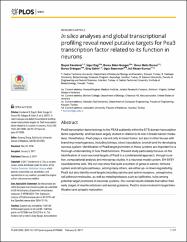In silico analyses and global transcriptional profiling reveal novel putative targets for Pea3 transcription factor related to its function in neurons

Göster/
Erişim
info:eu-repo/semantics/openAccessTarih
2017Yazar
Kandemir, BasakDag, Ugur
Bakir Gungor, Burcu
Durasi, Ilknur Melis
Erdogan, Burcu
Sahin, Eray
Sezerman, Ugur
Kurnaz Aksan, Isil
Üst veri
Tüm öğe kaydını gösterKünye
PLOS ONE Volume: 12 Issue: 2 Article Number: e0170585 DOI: 10.1371/journal.pone.0170585Özet
Pea3 transcription factor belongs to the PEA3 subfamily within the ETS domain transcription factor superfamily, and has been largely studied in relation to its role in breast cancer metastasis. Nonetheless, Pea3 plays a role not only in breast tumor, but also in other tissues with branching morphogenesis, including kidneys, blood vasculature, bronchi and the developing nervous system. Identification of Pea3 target promoters in these systems are important for a thorough understanding of how Pea3 functions. Present study particularly focuses on the identification of novel neuronal targets of Pea3 in a combinatorial approach, through curation, computational analysis and microarray studies in a neuronal model system, SH-SY5Y neuroblastoma cells. We not only show that quite a number of genes in cancer, immune system and cell cycle pathways, among many others, are either up- or down-regulated by Pea3, but also identify novel targets including ephrins and ephrin receptors, semaphorins, cell adhesion molecules, as well as metalloproteases such as kallikreins, to be among potential target promoters in neuronal systems. Our overall results indicate that rather than early stages of neurite extension and axonal guidance, Pea3 is more involved in target identification and synaptic maturation.

















